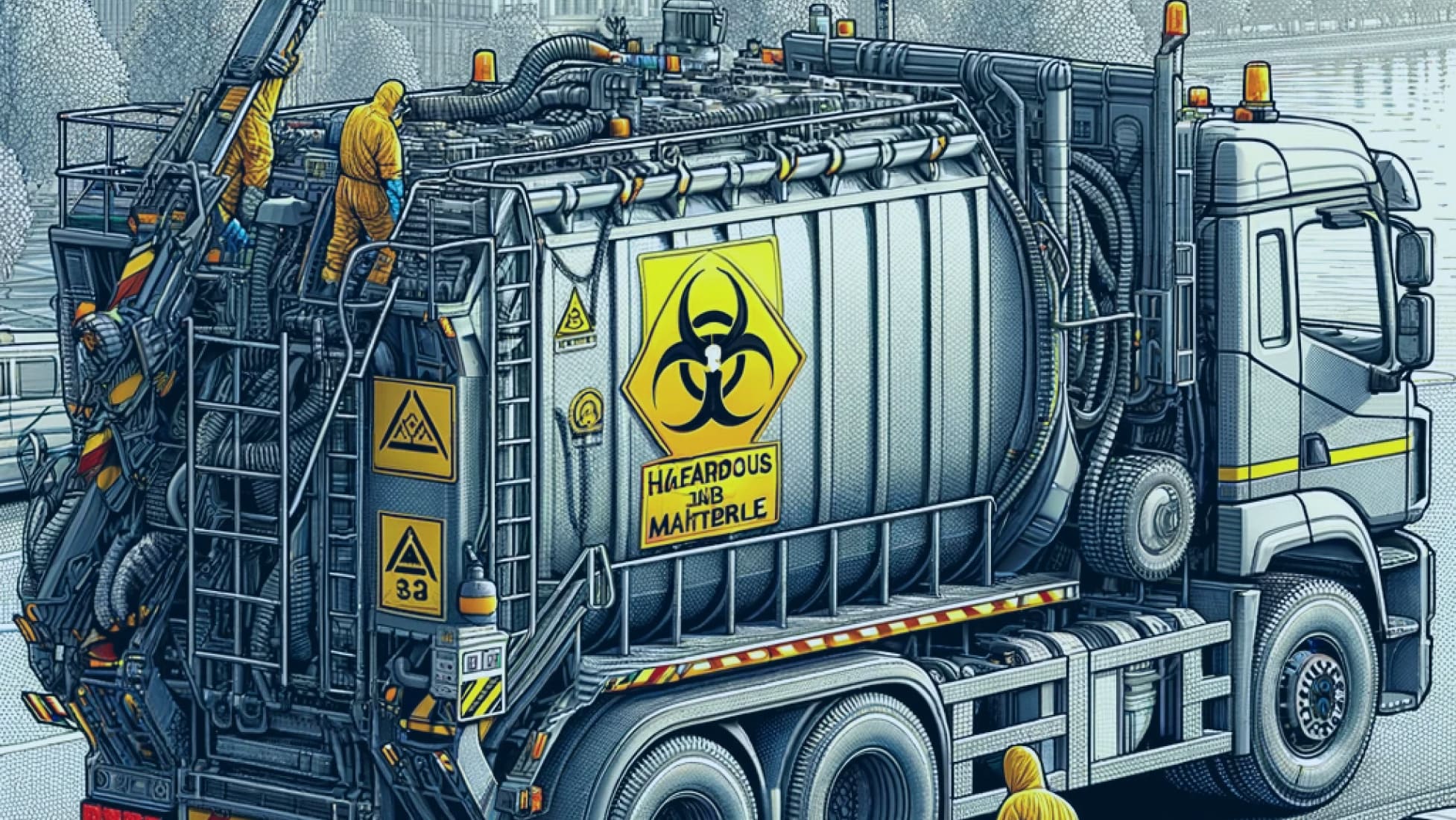Choosing the Right Hazardous Waste Tracking Software: A Guide

In our fast-evolving industrial world, the management of hazardous waste has become a critical concern for both environmental safety and regulatory compliance. Hazardous waste, if not properly managed, poses significant risks to both human health and the environment. This is where the role of hazardous waste tracking software becomes pivotal. It’s not just about meeting legal requirements; it’s about ensuring a safer and sustainable future. In this comprehensive guide, we’ll delve into how to choose the right hazardous waste tracking software, connecting these insights to our advanced waste collection software, a necessary tool for modern waste management challenges.
Understanding Hazardous Waste and Its Management
What is Hazardous Waste?
Hazardous waste includes any waste with properties that make it dangerous or potentially harmful to human health or the environment. The spectrum of hazardous waste is wide, ranging from industrial by-products to various chemicals used in numerous sectors. The challenge with hazardous waste is not just its safe disposal but also efficiently tracking its journey from creation to final disposal.
The Importance of Proper Management
Proper management of hazardous waste is crucial. This process involves safe collection, storage, transportation, treatment, and disposal of hazardous materials. Inadequate management of this waste can lead to significant environmental pollution, hefty legal penalties, and severe health hazards. An effective tracking system is not just a regulatory requirement; it’s a fundamental component of responsible environmental stewardship.
Role of Hazardous Waste Tracking Software
Hazardous waste tracking software plays a vital role in managing these wastes efficiently and effectively. It ensures compliance with environmental regulations and aids in maintaining accurate records, tracking waste movements, and managing documentation efficiently. The right software can transform a complex and risky process into a manageable, safer, and more efficient operation.
The Evolution of Waste Management Software
The journey of waste management software has been marked by significant technological advancements. In its early stages, waste management relied heavily on manual tracking and basic record-keeping systems. This approach was labor-intensive and prone to errors. However, the introduction of computers and database systems brought a revolution in this field. Software solutions became more sophisticated, offering better data management, efficient tracking, and comprehensive reporting capabilities.
With increasing environmental awareness and stricter regulations, software systems began to integrate regulatory compliance features. This integration ensured that companies could easily remain compliant with environmental laws, avoiding penalties and legal issues.
The most significant advancements in recent years include the development of real-time monitoring capabilities, cloud-based solutions for better accessibility and scalability, and the use of predictive analytics for informed decision-making. These innovations have transformed waste management from a reactive task to a proactive process.
Key Features of Hazardous Waste Tracking Software
When selecting hazardous waste tracking software, it’s essential to consider a range of features that ensure efficient and compliant waste management. These features include:
Compliance Management:
A cornerstone of any hazardous waste tracking software is ensuring adherence to local, national, and international environmental regulations. The software should be updated regularly to reflect any changes in these regulations.
Real-Time Tracking:
The ability to monitor waste movement in real time is crucial for immediate response and efficient management. It helps in identifying any issues quickly and taking prompt action.
Data Security and Backup:
Given the sensitive nature of the data involved in hazardous waste management, robust data security measures are a must. The software should also offer reliable backup systems to prevent data loss.
User-Friendly Interface:
An easy-to-use interface is essential for efficient operation. Employees should be able to navigate the software easily without extensive training.
Reporting and Documentation:
Automated report generation and document management are key features that save time and ensure accuracy in record-keeping.
Scalability:
This means it should be able to handle an increasing amount of data and more complex operations without compromising performance.
Customization:
The ability to customize the software according to specific organizational needs is a significant advantage. It allows the software to be more relevant and efficient for your specific processes.
Integration Capabilities:
The software should be compatible with other management systems and software used by your organization. This integration capability ensures a seamless flow of information across different departments and systems.
Benefits of Integrating Advanced Waste Collection Software
Integrating advanced waste collection software with hazardous waste tracking systems brings numerous benefits, significantly enhancing the efficiency and effectiveness of waste management processes. These benefits include:
Enhanced Efficiency:
Integration streamlines the waste collection and tracking processes, making them more efficient and less time-consuming.
Improved Accuracy:
Automated systems reduce the risk of human error in data entry and reporting, leading to more accurate and reliable data.
Cost Reduction:
By minimizing the need for extensive manual labor and reducing the risk of regulatory fines due to non-compliance, these systems can significantly reduce operational costs.
Better Compliance:
Advanced software assists in maintaining consistent compliance with regulatory requirements, an essential aspect of hazardous waste management.
Informed Decision Making:
These systems provide detailed data and analytics, which are crucial for strategic planning and making informed decisions.
Support for Sustainability:
By ensuring efficient and compliant hazardous waste management, these systems contribute to more sustainable business practices and environmental stewardship.
The integration of advanced waste collection software with hazardous waste tracking systems results in a comprehensive solution that addresses the complex challenges of modern waste management.
Choosing the Right Hazardous Waste Tracking Software: A Step-by-Step Guide
Selecting the right hazardous waste tracking software involves several critical steps to ensure that you choose a system that meets your specific needs and enhances your waste management processes.
Assess Your Needs:
Start by understanding your specific requirements for hazardous waste management. Consider the types of waste you handle, your operational scale, and any specific challenges you face in your waste management processes.
Market Research:
Explore the available software options in the market. Look for systems that are specifically designed for hazardous waste tracking and have a good reputation in the industry.
Check for Compliance Features:
It’s essential to ensure that the software you choose meets all regulatory requirements. This includes features for tracking, reporting, and documenting in accordance with local, national, and international laws.
Consider User-Friendliness:
Look for software that has an intuitive interface and is easy to use. Your staff should be able to navigate and utilize the software efficiently without requiring extensive training.
Evaluate Integration Capabilities:
Check if the software can be easily integrated with your existing systems and processes. This is important for ensuring a seamless flow of information and avoiding operational disruptions.
Scalability:
Consider the scalability of the software. It should be able to grow with your business and handle increasing amounts of data and more complex operations over time.
Request Demos and Trials:
Before making a final decision, request demos or trial periods for the software. This will give you a hands-on experience and help you evaluate its functionality and suitability for your needs.
Read Reviews and Feedback:
Look for reviews and feedback from other users. This can provide valuable insights into the software’s performance and reliability.
Compare Pricing:
Evaluate the cost of the software against the features and benefits it offers. Consider both the initial investment and any ongoing costs such as subscription fees or charges for updates and support.
Make an Informed Decision:
Based on your assessment, choose the software that best fits your organizational needs and will effectively support your hazardous waste management processes.
Taking the time to carefully select the right hazardous waste tracking software will pay off in the long run by enhancing your waste management efficiency, ensuring compliance, and contributing to your overall operational success.
Trends in Hazardous Waste Tracking Software
The field of hazardous waste tracking software is rapidly evolving, driven by technological advancements and changing regulatory landscapes. Some of the current trends in this field include:
AI and Machine Learning:
The incorporation of artificial intelligence (AI) and machine learning algorithms is becoming increasingly common in hazardous waste tracking software. These technologies enable more sophisticated data analysis, predictive maintenance, and efficient decision-making.
Mobile Accessibility:
With the widespread use of smartphones and tablets, mobile accessibility is becoming a key feature in waste tracking software. Mobile apps allow waste management professionals to manage operations on-the-go, enhancing flexibility and responsiveness.
Enhanced Customization:
There is a growing trend towards offering more customizable features in hazardous waste tracking software. This allows organizations to tailor the software to their specific industry needs and operational processes.
Integration with IoT Devices:
The integration of Internet of Things (IoT) devices is another emerging trend. IoT devices can be used for automated data collection, real-time monitoring, and more efficient management of hazardous waste.
Advanced Reporting Tools:
Modern hazardous waste tracking software increasingly offers advanced reporting tools. These tools allow organizations to generate comprehensive and customizable reports, providing valuable insights for decision-making and regulatory compliance.
Focus on User Experience:
There is a heightened focus on enhancing the user experience in hazardous waste tracking software. This includes developing software that is not only functional but also easy to navigate and engaging for users.
These trends indicate a move towards more intelligent, flexible, and user-centric hazardous waste tracking systems. Staying abreast of these trends is important for organizations looking to leverage the latest technological advancements in their waste management processes.
Implementation and Training
Successfully implementing new hazardous waste tracking software and ensuring that your staff are fully trained to use it is crucial for maximizing its benefits. Here are some key considerations for effective implementation and training:
Develop a Structured Implementation Plan:
Start with a clear and structured plan for implementing the new software. This should include a timeline, key milestones, and designated responsibilities for your team members.
Provide Comprehensive Training:
Ensure that your staff receive comprehensive training on how to use the new software. This training should cover all aspects of the software’s functionality and how it integrates with your existing processes.
Ensure Ongoing Support:
Maintain ongoing support and communication with the software provider. This includes access to customer support for troubleshooting, as well as updates and enhancements to the software.
Establish a Feedback Loop:
Implement a feedback mechanism to gather input from your staff on the software’s performance and usability. This feedback can be used for continuous improvement and to address any issues that arise during implementation and use.
A well-planned and executed implementation and training program is essential for ensuring that your staff are confident and proficient in using the new software, leading to more effective and efficient hazardous waste management.
Conclusion
Choosing the right hazardous waste tracking software is a critical decision for any organization involved in the management of hazardous waste. The right software can significantly enhance your waste management processes, ensuring compliance, efficiency, and contributing to environmental sustainability. As the field of waste management continues to evolve, staying informed about the latest software features and trends is crucial. By carefully selecting and effectively implementing the right software, you can ensure that your organization is well-equipped to handle the complex challenges of modern hazardous waste management.




